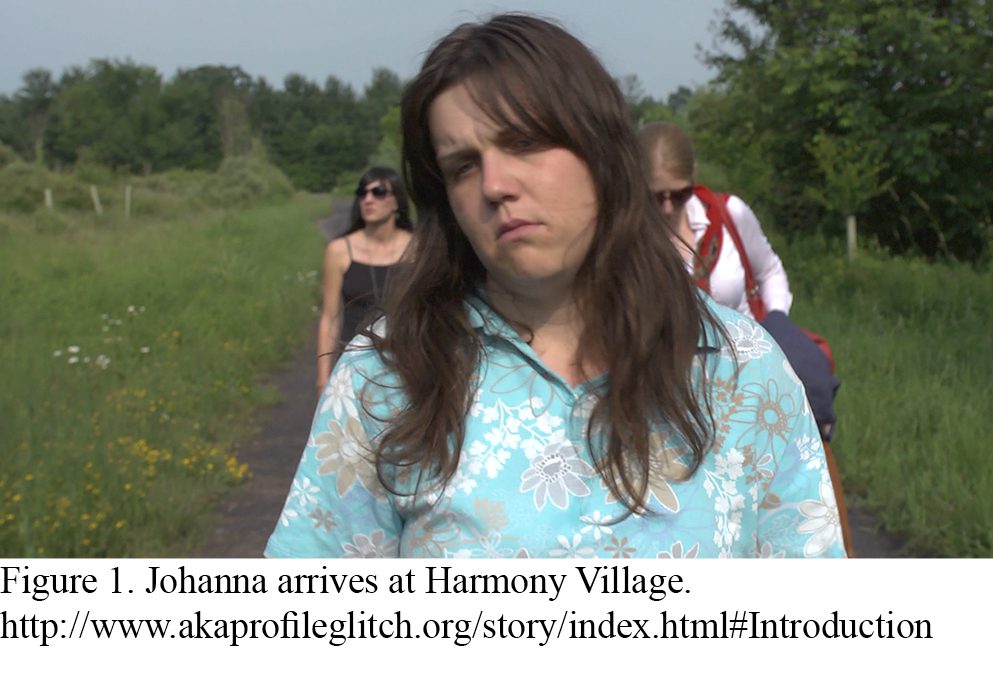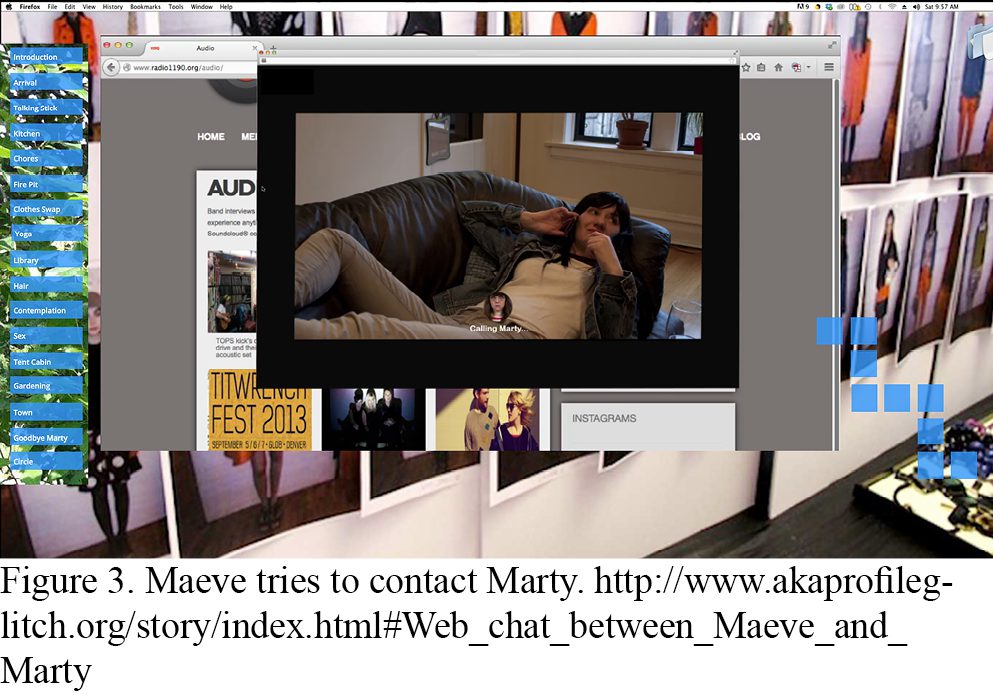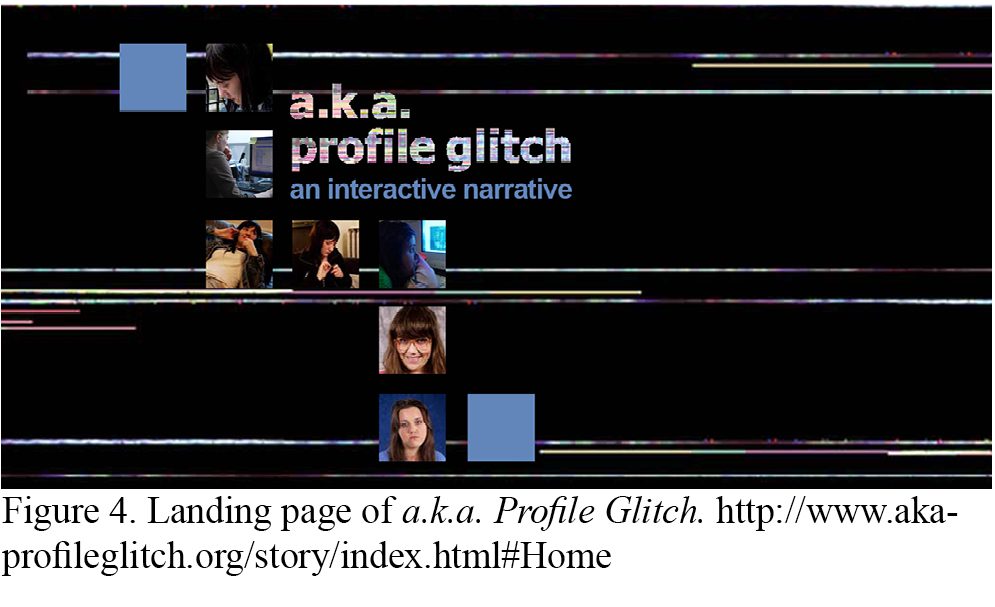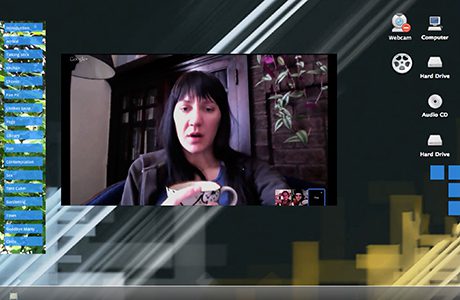
Abstract
a.k.a. Profile Glitch (http://www.akaprofileglitch.org/story/index.html) is an interactive online narrative about three characters, Marty, Maeve and Johanna, who meet at Harmony Village, an intentional community located outside of Ithaca, New York. (Figure 1) The unique emotional and physical dynamics of communal life, with its own constructed social norms and rules of conduct, creates an intense interpersonal experience. Marty, Maeve, and Johanna develop a deep, unlikely friendship that is possible because of the unique social context of the commune. After several months, Marty, Maeve, and Johanna each decide to return home and the dynamics of their relationship is altered. Marty begins blogging about her experiences at Harmony Village and in the process reveals information about Johanna and Maeve that they are not comfortable with. Maeve and Johanna confront Marty through a series of online conversations. The conflict between the characters highlights issues of self-identity and self-representation in different social contexts and how new technologies of the networked public disrupt the way people perform their identity online.
Keywords
networked, publics, collapsed, context, performance, identity, glitch
Performance of the Self in the Networked Era
a.k.a. Profile Glitch looks at how digital technologies impact the performance of the self on-line and how the networked construction of persona is complicated because of the increased probability of “collapsed contexts,” or the collision of multiple social contexts. [1] The moment a persons’ self-presentation is threatened by the introduction of conflicting information, an interpersonal glitch occurs. Networked publics, featuring user-generated content, transgress boundaries between digital and physical space, representation and performance, and private and public interactions.

The profile image is a good example of how social network users create an on-line identity with digital artifacts. The profile picture is the most noticeable component of one’s digital identity and the regular updating of a profile picture can be considered a performative act. (Figure 2) Online profiles do not just depict the individual it belongs to, but help shape the representation of others connected to the individual on the social networked site. The online profile is not a static representation of self, but is a “communicative body in conversation with other represented bodies.” [2] As more people enter the conversation and add information to the digital represented body, the greater the probability that an interpersonal glitch will occur.
a.k.a. Profile Glitch illustrates the implications the networked public has on the performance of identity by tracing the interrelations between three characters as their friendships move from a close, intimate, physical experience of the commune to the networked realm of online communications. Johanna is confronted with the fact that Marty’s blog could reveal to her family the truth about how she spent her summer living at a commune, having sex with a hippy. Maeve’s feelings are hurt by the way Marty portrays their relationship in her blog and tries to confront her about what actually happened, only to be met with the cold shoulder. (Figure 3) Marty’s self-representation online is much more polished, professional, and stuffy compared to how she behaves in person; a charade only Maeve and Johanna seem to be able to see through. The conflict and the anxiety felt by Johanna and Maeve are exaccerbated by the increased likelihood of context collapse created by the new networked public.

Fragments of Content
The online interface of a.k.a. Profile Glitch is designed to mimic the experience of navigating online content through multiple windows and platforms. The landing page offers seven different entry points into the story. (Figure 4) Each entry point leads to a scene of the characters interacting after they have moved home from Harmony Village. The visual backdrop reflects one of the characters’ personal space and provides visual information about the person.On the left of each screen, a second menu appears with descriptive labels such as, “Talking Stick,” “Fire Pit,” and “Goodbye Marty”. These links go to scenes at Harmony Village, and serve as backstory for the conflict that transpires online.

The overall design of the graphical user interface is intended to create a fragmented view of the characters. Just as users of social media platforms piece together fragments of content to construct an identity of the people they interact with, [3] viewers of a.k.a. Profile Glitch are given bits of information about Marty, Maeve, and Johanna. Through cognitive and visual associations, the viewer constructs a totality of the narrative.
References
1. Meyrowitz, Joshua. No Sense of Place: The Impact of Electronic Media on Social Behavior. New York: Oxford UP, 1985.
2. boyd, danah and Jeffrey Heer. “Profiles as Conversation: Networked Identity Performance on Friendster.” In Proceedings of the Hawai’i International Conference on System Sciences (HICSS-39), Persistent Conversation Track. Kauai, HI: IEEE Computer Society. January 4 – 7, 2006.
3. Turkle, Sherry. Life on the Screen: Identity in the Age of the Internet. New York: Simon & Schuster, 1995.
Acknowledgements
aka Profile Glitch was produced in collaboration with a highly talented creative team: Lindsey Martin, Dorothea Otto, and Julia Fuller.



